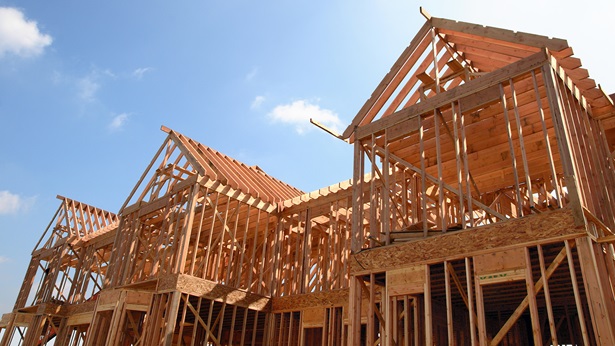NAHB in the News
Housing is a critical issue across the U.S., and NAHB continues to put housing at the forefront of the national media to address key policies and topics to help Americans access safe, affordable housing.
See top recent clips and excerpts below for key NAHB messages and trending topics.
The Washington Post
Home builders are cheering Trump’s return to the White House
(Subscription may be required.)
In Birmingham, Alabama, Alicia Huey’s custom and spec homes can fetch $850,000 to $1.5 million. She rode the supply chain swings of the pandemic: At one point, lumber for a 3,200-square-foot home spiked from $35,000 to $125,000. Projects that typically took eight months stretched into a year.
But Huey said regulations that can seem arbitrary consistently add the most costs and wait times to her business, AGH Homes. Once, a client hired Huey to add a fence on to her property. But since the lot backed up to a drainage ditch, which fed into a creek, Huey would have had to get a special wetlands permit before putting posts in the ground, so the client abandoned the project, she said.
“She got a new dog, and her dog would have been long gone by the time we would have gotten the fence up, probably,” Huey said. “It was a little bit of overreach, I thought.”
***
For now, builder Carl Harris is feeling bullish in Wichita, Kansas. His standard home — five-bed, three-bath — typically sells for $450,000. Harris expects more people will be shopping around as mortgage rates cool off. And he’ll be ready.
“I’ve got requests in to do some more specs. I’m buying lots. I’m feeling good,” said Harris, who is also the chairman of NAHB. “I’m feeling as good as I’ve felt for a few years.”
The Wall Street Journal
Construction Industry Braces for One-Two Punch: Tariffs and Deportations
(Subscription may be required.)
Overall, about 7.3% of home-building materials are imported, according to the National Association of Home Builders. Softwood lumber, used to frame buildings, often comes from Canada, which now has a tariff of 14.54%. The U.S. is also the world’s top importer of the crucial housing materials iron and steel. About a quarter of America’s $43 billion in imported iron and steel came from Canada as of 2022, according to the Observatory of Economic Complexity.
Another key home-builder import from both Mexico and Canada is cement. The U.S. imported $512 million of cement from Canada and $254 million from Mexico in 2022. Gypsum, which is used to make drywall, is also imported from both countries and has already jumped nearly 50% in price since 2020, NAHB said.
MarketWatch
Will home prices crash in 2025? Here’s what experts say.
(Subscription may be required.)
Immigrants form a significant chunk of labor in the construction industry. In 2023, the share of immigrants in construction reached a new record high of 25.5%, according to a blog post by the National Association of Home Builders. In the trades, such as in plumbing or roofing, the share of immigrants is even higher, the trade group noted, with “one in three craftsmen coming from outside of the U.S.”
Mansion Global
Trump Policies Remain a Wild Card as U.S. Housing Market Heads Toward Slow Recovery Next Year
(Subscription may be required.)
Republicans winning the presidency and both houses of Congress will likely be a mixed bag for the housing market, though increasing housing inventory appears to be on President-elect Donald Trump’s radar. Among his housing-related proposals are making federal land available for home construction and addressing regulations, which add more than an estimated $90,000 to the cost of a new home, according to a study by the National Association of Home Builders.
What’s New – The Wall Street Journal Podcast
How Trump’s Policies Could Ripple Through the Housing Market
On the tariff side, Trump has proposed 25% tariffs on Canada and Mexico, which could impact construction materials. A lot of wood is imported from Canada. There’s a lot of steel that is imported. Overall, about 7.3% of home building materials are imported according to the National Association of Home Builders. So construction leaders are bracing for this, causing the cost of housing to go up, which is problematic because actually lowering the cost of housing was a large part of the campaign.
Marketplace
Awaiting immigration crackdown, some homebuilders wonder who’ll build the homes
“When you kind of get down to the subcontractors that work in the residential space in particular, you’re talking about a full third of the workers are immigrants,” said Jim Tobin, CEO of the National Association of Home Builders.
The workforce is still recovering from the housing crash that triggered the Great Recession in the 2000s, Tobin said. Many workers left the industry and never came back. As skilled tradespeople have aged and come closer to retirement, fewer young people have entered the pipeline.
“Immigrant labor makes up that shortfall in the labor pool that we don’t have because we’re not either attracting domestic workers or training enough domestic workers to fill the roles that we need,” Tobin said.
***
Because of the lack of labor, Tobin said, homebuilders are concerned about the incoming Donald Trump administration’s immigration policies. The president-elect has promised mass deportations of unauthorized immigrants. The Pew Research Center estimates 13% of construction workers are in that category.
Even the threat, Tobin said, could have a chilling effect. “Just even talking about mass deportations could take people, you know, off of job sites and melting back into the shadows.”
Tobin said his association has been pushing for a new visa program for construction workers.
The New York Times
Can the U.S. Climb Out of Its ‘Unprecedented’ Housing Crisis?
(Subscription may be required.)
There is some optimism on the inventory front. The National Association of Home Builders is expecting construction to start on about one million single-family homes next year. And there’s been a construction boom in the rental market from projects that began during the pandemic, with one million new multifamily units coming to market in 2024 and 2025, a 50-year high. This influx means that rents could at least remain flat in 2025, as they did in 2024.
MarketWatch
Will Trump’s tariffs raise domestic prices? Yes — if Biden’s tariff policies are a guide.
(Subscription may be required.)
Robert Dietz, chief economist at the National Association of Home Builders, said lumber prices have increased 13.1% over the past eight weeks.
The NAHB opposed the lumber tariffs, saying they would hurt housing affordability and would be a cost escalator for housing construction.
Yahoo Finance
This could lead to a ‘golden age of housing production’: NAHB CEO
NAHB CEO Jim Tobin sits down with Brad Smith on Wealth to have a conversation about housing demand and affordability.
“If we look at ways that we can release those lots, I think that is the one thing I would ask local governments to do is, is we get ready for what I think is going to be a golden age of housing production over the next 4 or 5 years,” Tobin tells Yahoo Finance. “We really need to get those pieces of land in the pipeline now, and we need to get them in there affordably so that we can meet demand in the future.”
CNN
The US housing market has had a tough year. Here’s what could save it
(Subscription may be required.)
“A slower path of Fed rate cuts for 2025 will keep builder and developer construction loan interest rates higher than previously expected and act as an additional headwind for gains in housing supply,” Robert Dietz, chief economist at the National Association of Home Builders, wrote in a blog post Wednesday.
The Wall Street Journal
How Trump Can Ease the Housing Crisis
(Subscription may be required.)
Third, roll back energy regulations that drive up homeownership costs. The nonprofit Alliance for Consumers finds that Biden-Harris energy regulations have added up to $9,166 in household expenses per home. In April, the Department of Housing and Urban Development mandated that federally financed homes be built in compliance with the 2021 International Energy Conservation Code. According to the National Association of Homebuilders, these stringent regulations could add as much as $31,000 to the price of a new home. It could take up to 90 years for some home buyers to break even on this added cost.



